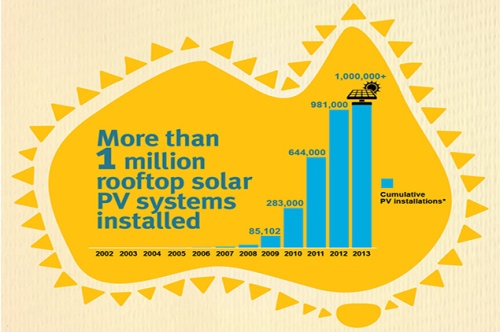In my travels around the internet I found this site put together by the Australian PV Institute showing the level of installation of solar photovoltaic panel installation by postcode or Local Government area.
In Fawkner there have been about 246 solar PV installations. This amounts to approximately 5.4% of the estimated 4520 dwellings in our suburb with an installed capacity of 571kW.
This is lower than the Moreland average of 6.1%. Moreland Local Government Area (LGA) and is also below other municipal areas in Melbourne’s north. Maribyrnong has 7% solar installation, Moonee Valley is on 6.5%, Darebin is on 6.9%, Banyule on 6.7%, Whittlesea on 9.7%, and Hume on 11%.
I made up this table to show the relative level of installation of solar panels across Moreland:
| Suburb | Total Dwellings | Dwellings installed | Percent | Installed capacity |
|---|---|---|---|---|
| Fawkner 3060 | 4520 | 246 | 5.4% | 571kW |
| Hadfield, Glenroy and Oak Park 3046 | 11482 | 635 | 5.5% | 1391kW |
| Coburg 3058 | 11303 | 835 | 7.4% | 1990kW |
| Pascoe Vale 3044 | 9127 | 546 | 6% | 1238kW |
| Brunswick 3056 | 7014 | 389 | 5.5% | 835kW |
| Brunswick South, Brunswick West, Moonee Vale, Moreland West 3055 | 3933 | 246 | 6.3% | 563kW |
| Moreland LGA | 56139 | 3343 | 6.1% | 7666kW |
There is a substantial opportunity to increase residential rollout of solar PV panels in Fawkner and in Melbourne’s north to keep the pressure on reducing carbon emissions. Solar panels reduce peak demand on base load power stations. This is particularly important in Victoria where we have some of the most polluting power stations which burn carbon intensive brown coal.
On a global level, Italy (16%) & Germany (32%) accounted for almost half of global solar PV capacity installed up to 2012, according to The Climate Group (@ClimateGroup) in a tweet.
Moreland Council achieved carbon neutrality in 2013 with carbon Offsets
Moreland Council has installed solar panels on Council buildings and currently purchases 100% Green power, with an aggressive energy efficiency campaign to reduce Council energy usage. Think about all the street lights which Moreland has been changing over to the much more efficient and long lasting LED lights. Through buying carbon offsets – an accredited program financing wind power generation in India – it has achieved carbon neutrality this year. This is a positive step, although Council needs to continue to reduce energy and carbon emissions to reduce the level of carbon offsets purchased.
Moreland Council are also presently preparing a climate action plan 2020 in conjunction with the Moreland Energy Foundation with an aim to make the municipality – that’s all of us – carbon neutral by 2020.
If you need assistance with reducing your energy usage MEFL’s Positive Charge can assist with advice, assessment and products.
Solar revolution lead by ordinary Australians as Government action falters
One of the last major reports of the Climate Commission before it was abolished by the new Abbott Government was The Critical Decade: Australia’s future – solar energy (PDF). It was written by Professor Tim Flannery and Professor Veena Sahajwalla. The report highlighted that ordinary Australian households were leading an energy revolution with more than one million rooftop solar PV systems installed by May 2013 in just a few years.
Climate scientists continue to say this is the critical decade for climate action. With the Abbott Government attempting to dismantle the effective but limited policies of the former Labor Government, and obstructing international climate negotiations in Warsaw, it is time for individuals, businesses to step up to taking action.
The current conservative Victorian Government lead by Premier Denis Napthine has backtracked on it’s bipartisan support for climate action and rollout of solar power of the previous State Labor Government and is currently considering 13 billion tonnes of brown coal allocation to develop a coal export industry.
We need to keep holding our State and Federal Governments accountable to Australian public opinion on action on climate change and carbon pricing.









It’s great to see new PV installations as we travel around Fawkner, but I have to wonder if there has been a drop off in new installations during 2013. We were lucky enough to sneak in on the 33c feed in tariff in September 21013, but we’ve been approached by several passersby who have commented that they would not bother now due to the 9c feed in. I think the state Government needs to revisit the feed in tariff if there is an likelihood of seeing an ongoing increase in installations.
This reduction to 8c/kWh was made by the Baillieu Government and brought into effect from 30/9/2012. I agree, the Feed in Tariff (FIT) of 8c is too low and a disincentive The Solar Industry wanted a rate of 12c to 16c/kWh at the time, but this was ignored. I think a fairer price would be retail parity to match the rate of grid supply being charged.
Because the FIT is so low now, the Return on Investment is much longer, with a need to consider maximising usage during the day to get the maximum benefit: do the clothes washing, dishwasher, have people at home using energy produced by the panels. Of course the ROI doesn’t take into account the intangible benefits of reduced emissions.
Pingback: Victorian Premier warns 100,000 premises may lose power during extreme heatwave | Climate Action Moreland: people in Brunswick, Coburg, Fawkner and Glenroy wanting action on climate change
Pingback: The challenge of adapting to climate change and heatwaves in Melbourne | Talking About NMIT
Pingback: Talking about Melbourne PolytechnicThe challenge of adapting to climate change and heatwaves in Melbourne - Talking about Melbourne Polytechnic
Pingback: Moreland roofs now generate 12MWh power annually from Solar PV | Climate Action Moreland: people in Brunswick, Coburg, Fawkner and Glenroy wanting action on climate change
Pingback: Adapting to climate change and heatwaves in Melbourne